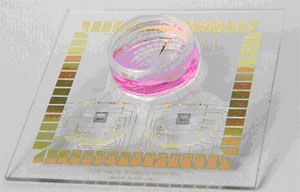Cultural neuron cultures

BrainWaves is a musical performance by cultured cortical cells interfacing with multielectrode arrays. Eight electrodes recorded neural patterns that were filtered to eight speakers after being sonified by robotic and human interpretation. Sound patterns followed neural spikes and waveforms, and also extended to video, with live visualizations of the music and neural patterns in front of a mesmerized audience. See a two minute video here (still image below). Teams from two research labs designed and engineered the project; read more from collaborator Gil Weinberg.

The Potter Group of the Laboratory for Neuro-
Engineering at the Georgia Institute of Technology conducts research with cultured neuro-electrical interfaces, using recording and stimulation
techniques. BrainWaves is one creative expression of this work, another is the MEART Animat, or hybrot, that creates paintings with robotic arms. The Animat used rat neurons; mouse neurons for BrainWaves, and simple fish neurons in Fish and Chips (a predecessor of BrainWaves). Organic and digital meshed.
BrainWaves invokes aesthetics of sound patterns with neural patterns. MEART "the semi-living artist" is abstract in its output. What do these expressions mean? Their beauty lies in science, in the synchronized creative outlets in live, improvised performances with digital and audience interfaces generating compositions in reaction to neural activity. Then putting them online. Two, including BrainWaves, were documented in Interactive Sonification of Neural Activity, Weinberg & Thatcher, from Proceedings of the 2006 International Conference on New Interfaces for Musical Expression. (PDF)
Potter recently published on plasticity in neuronal cultures, and earlier in the year co-authored An extremely rich repertoire of bursting patterns during the development of cortical cultures. Wagenaar, Pine, Potter; BMC Neurosci. 2006 Feb 7;7:11 (free full text).
The paper includes an open invitation. "Indeed, the range of behaviors of these cultures is so rich that this paper can only begin to describe the diverse activity patterns present in these recordings. Therefore, we invite others to join us in the study of activity patterns of networks of cortical cells in vitro. To this end, we have made the entire dataset used for this paper available on the web [email Potter for access]. Researchers may download our recordings of spike waveforms."
Imagine what sci-art expressions could develop in the research and infoviz from that.





1 Comments:
I read something today about cultured neurons successfully landing a plane in a flight simulator!
Post a Comment
<< Home